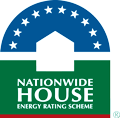The thermal performance in a residential building is a dwelling's ability to stay naturally cool in summer and naturally warm in winter. House Energy Rating Software evaluates the thermal efficiency of a new dwelling's design with the thermal comfort level set at around 20ºC to 22ºC for Australia.
| The resulting Thermal Performance Assessment is then given a star rating between 0 to 10 stars, the higher the stars the better the thermal performance. Here are a couple of examples: | |
| • | If the assessment only achieves 3 stars then there is a greater need for the use of heating and/or cooling energy to achieve one's comfort level, more running costs to the owner. |
| • | If the assessment achieves 6 stars plus then there is a lesser need for the use of heating and/or cooling energy to achieve one's comfort level, a lesser cost to the owner. |


